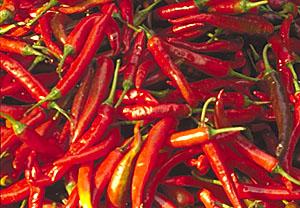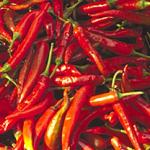The Food of Thailand
A blend of the Chinese and Indian cuisines, the food of Thailand is unique among the cuisines of Southeast Asia. In the past few decades, this country's kitchen delights have spread across the globe at a speed unprecedented by the culinary arts of any other nation. Thai food has captured the world's palates by its rich variety, intense flavors, fragrant aromas, succulent spicy taste and eye-appealing presentations.
Today, the cuisine of Thailand, distinct in its own right and widely recognized as one of the world's finest edibles, can be found in almost every corner of North America and in any part of Europe. According to some surveys, more than a quarter of North Americans are familiar with Thai food, and those who try it are usually ensnared by that Far Eastern cuisine.
The Thai kitchen, which has the quality and consistency of Chinese food and the spiciness of Mexican cuisine, originated in the Guangsi-Gueizhou region of southwestern China - the original homeland of the Thai people. This regional Chinese kitchen was later enriched by the foods brought in by foreign traders and the wealth of tropical fruits and vegetables, fish, herbs and spices found in the country. The Thais have been able to absorb foreign influences and evolve these into something uniquely their own. The country's culinary art is today a combination of Eastern and Western foods, harmoniously combined. The skill of blending five flavors - bitter, hot, salty, sweet and sour - is the trademark of Thai food.
In the main, Thai food can range from the mild to fiery hot and spicy, oozing with unique flavors and mouth-watering aromas. Anise, basil, coconuts and their milk, fresh coriander, curries, galangal, garlic, ginger, lemon grass, lime juice, mango, onions, salted cabbage palm sugar and tamarind; and eggs, soybeans, fish, oyster and soy sauces, are some of the ingredients employed in enhancing the country's cuisine. The ideal Thai meal is a homogeneous blend of spices, producing a subtle sweet and sour taste. The dishes are always meant to be equally satisfying to eye, smell and taste.
A Thai meal usually consists of a number of dishes and condiments served with rice as the centerpiece. The dishes complement each other in flavor and texture. Bitter, piquant and sharp tasting foods are tempered by sweets such as coconut milk and palm sugar. The nuttiness of nuts and the saltiness of some sauces are balanced by zesty fish condiments; the hot peppers are tempered by lime juice; and tamarind is balanced by lemon-grass.
A typical Thai meal includes a soup, rice or noodles, a steamed dish, a fried dish, a hot salad and a variety of sauces into which food is dipped. Steaming, frying and stir-frying are the main cooking methods. All the dishes are served at once, and diners can sample the dishes against a background of rice, combining or tasting, separately, each dish, according to the individual's taste. Rice is an essential ingredient in most Thai meals and the side dishes act as condiments for this staple of Asia.
Meats and vegetables are served in bite-sized chunks and, hence, there is no need for a knife and only a spoon and fork are used when dining. Sometimes a whole meal, based on rice or noodles with meat, chicken or seafood and vegetables, is served in a single dish or bowl along with condiments and sauces. Typically, all meals end with elaborate sweet desserts and/or a variety of fresh-cut fruits.
Thai salads such as som tam and yam som oh, with a combination of sweet, sour and spicy dressings are pungent, hot and crispy. As for soups, such as tom yum koong (hot and spicy shrimp soup) and tom kha (coconut herb soup), with their meat, vegetable and rice or noodle components, they often serve as an entire meal. Lunches are usually a one-dish meal. Seasoning sauces and pastes such as nam pla (salted fermented fish sauce), nam prik num (a chilli and eggplant-based sauce), kapi (fermented shrimp paste) and ingredients such as dried prawns, are characteristic of Thai cooking.
For main courses, chicken, beef, pork and shrimp - the most common seafood - are used alone or in combination with other meats. However, for vegetarians, dishes such as pad paak ruamit (stir-fried vegetables) and the bean-curd, tofu, are great substitutes for the meats. From the huge Thai kitchen some of the most common main dishes are: eggplant with tofu, nue gra pao (stir-fried beef), gai pad khing (ginger chicken), thot man pla (fried fish cakes), and Kraphong Khao Priao Wan (sweet and sour fish).
As for Thai desserts, a good number feature bananas such as kluay cap (fried bananas), klai buad chi (bananas in coconut milk), and kluay ping (bananas grilled, then soaked in syrup). Competing with bananas are coconut based desserts such as sangkha-yaa ma-phrao (coconut custard) and ta-koh (Thai jelly with coconut cream). Many of the Thai desserts are enhanced by the delicate taste of coconut milk and flavored with aromatic pandan leaves and jasmine flowers.
The aroma coming out of the Thai kitchen not only conveys flavor, but also gives an aura of freshness. However, garnishing the food is what completes its culinary appeal. Attractive presentation is as important as exquisite taste. Roasted peanuts, bean sprouts, chilli peppers, fresh coriander, sculptured fruits and shallots, used as garnishes, provide the dishes with a mouth-watering enticement.
Thai dishes are not difficult to prepare, but some of the ingredients could be hard to find in some Western countries. For this reason, some of the original ingredients can be replaced by internationally accessible ingredients which are evident in a number of the recipes below. Also, the recipes have been simplified in order that foreign housewives and cooks will become familiar with the delightful culinary world of Thailand.
* * * * *
Recipes:
Thai Peanut Sauce
Som Tam- Shrimp Salad
Tom Yum Koong - Shrimp Soup
Eggplant With Tofu
Nue Gra Pao: Stir-Fried Beef
Gai Pad Khing - Ginger Chicken
Thot Man Pla - Fried Fish Patties
Kraphong Khao Priao Wan - Sweet and Sour Fish
Pad Paak Ruamit - Sir-Fried Vegetables
Thai Style Cooked Rice
Klai Buad Chi - Bananas in Coconut Milk
* * * * *
 ThingsAsian
ThingsAsian

















